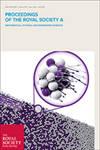High– and low–cycle fatigue crack initiation using polycrystal plasticity
Proceedings of the Royal Society of London. Series A. Mathematical and Physical Sciences
Pub Date : 2004-07-08
DOI:10.1098/rspa.2003.1258
引用次数: 236
Abstract
A polycrystal plasticity finite–element model has been developed for nickel–base alloy C263. That is, a representative region of the material, containing about 60 grains, has been modelled using crystal plasticity, taking account of grain morphology and crystallographic orientation. With just a single material property (in addition to standard elastic properties), namely, the critical resolved shear stress, the model is shown to be capable of predicting correctly a wide range of cyclic plasticity behaviour in face–centred cubic nickel alloy C263. A fatigue crack initiation criterion is proposed, based simply on a critical accumulated slip. When this critical slip is achieved within the microstructure, crack initiation is taken to have occurred. The model predicts the development of persistent slip bands within individual grains with a width of ca. 10 μm. The model also predicts that crack initiation can occur preferentially at grain triple points under both low– (LCF) and high–cycle fatigue (HCF). For the case of HCF, this also corresponds to a free surface. The polycrystal plasticity model combined with the fatigue crack initiation criterion are shown to predict correctly the standard Basquin and Goodman correlations in HCF, and the Coffin–Manson correlation in LCF. The model predictions are based on just two material properties: the critical resolved shear stress and the critical accumulated slip. Just one experimental test is required to determine these properties, for a given temperature, which have been obtained for nickel alloy C263. Predictions of life for nickel alloy C263 are then made over a broad range of loading conditions covering both LCF and HCF. Good agreement with experiments is achieved, despite the simplicity of the proposed ‘two–parameter’ model. A simple three–dimensional form of the model has provided an estimate of the fatigue limit for HCF crack initiation in C263.利用多晶塑性引发高、低周疲劳裂纹
建立了C263镍基合金的多晶塑性有限元模型。也就是说,考虑到晶粒形态和晶体取向,使用晶体塑性对含有约60个晶粒的材料的代表性区域进行了建模。只有一个单一的材料特性(除了标准的弹性特性),即临界分解剪切应力,该模型被证明能够正确预测面心立方镍合金C263的大范围循环塑性行为。提出了一种基于临界累积滑移的疲劳裂纹萌生准则。当这一临界滑移在微观结构内达到时,就被认为发生了裂纹萌生。该模型预测在单个晶粒内形成宽度约为10 μm的持久滑移带。该模型还预测,在低周疲劳和高周疲劳下,裂纹萌生都优先发生在晶粒三点处。对于HCF,这也对应于一个自由曲面。结合疲劳裂纹起裂准则的多晶塑性模型能够正确预测高强度复合材料的标准Basquin和Goodman关联,以及低强度复合材料的Coffin-Manson关联。模型预测仅基于两种材料特性:临界分解剪应力和临界累积滑移。在给定的温度下,只需要进行一次实验测试就可以确定镍合金C263的这些特性。然后,对镍合金C263的寿命进行了广泛的预测,包括LCF和HCF的加载条件。尽管提出的“双参数”模型很简单,但与实验结果很吻合。该模型的一个简单的三维形式提供了C263中HCF裂纹萌生的疲劳极限估计。
本文章由计算机程序翻译,如有差异,请以英文原文为准。
求助全文
约1分钟内获得全文
求助全文
来源期刊
自引率
0.00%
发文量
0
期刊介绍:
Proceedings A publishes articles across the chemical, computational, Earth, engineering, mathematical, and physical sciences. The articles published are high-quality, original, fundamental articles of interest to a wide range of scientists, and often have long citation half-lives. As well as established disciplines, we encourage emerging and interdisciplinary areas.

 求助内容:
求助内容: 应助结果提醒方式:
应助结果提醒方式:


